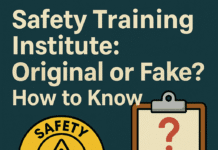
Certified Safety Professional (CSP): Ensuring Safety in Every Workplace
Introduction to Certified Safety Professional (CSP)
In today’s fast-paced and dynamic work environments, the safety of employees and the protection of assets have become critical priorities for organizations. A Certified Safety Professional (CSP) plays a pivotal role in ensuring workplace safety and mitigating potential risks. A CSP is a highly trained and skilled professional who possesses the expertise to identify and address safety hazards, promote best practices, and develop comprehensive safety programs to safeguard workers and the environment.
The Importance of Safety in the Workplace
Workplace safety is paramount, regardless of the industry or sector. Accidents, injuries, and incidents can lead to severe consequences for both employees and employers. Employers are increasingly recognizing the need for a dedicated safety expert who can develop strategies and implement measures to prevent accidents and create a safer work environment. The role of a CSP is crucial in achieving these objectives.
The Role of a CSP
Certified Safety Professionals are responsible for designing and implementing safety policies, procedures, and training programs that comply with regulatory standards. They work in collaboration with management and employees to identify potential hazards and develop strategies to minimize risks. A CSP acts as a consultant, advisor, and educator, ensuring that everyone in the organization is aware of and follows safety protocols.
Benefits of Hiring a CSP
Hiring a Certified Safety Professional offers several advantages. First and foremost, it significantly reduces the risk of workplace accidents and injuries, leading to reduced workers’ compensation claims and medical costs. Moreover, a safer work environment enhances employee morale and productivity, as workers feel valued and protected. This, in turn, fosters a positive corporate culture and improves the company’s reputation.
Becoming a Certified Safety Professional
Becoming a CSP requires a combination of education, experience, and passing the CSP exam. Aspiring candidates must fulfill specific eligibility requirements to qualify for the certification process.
Eligibility Requirements
Typically, candidates should possess a minimum of a bachelor’s degree in occupational safety, health, or a related field, along with professional experience in safety management. The exact experience requirements may vary based on the candidate’s educational background. Additionally, applicants must demonstrate competence in safety through documented professional accomplishments.
CSP Exam Overview
The CSP exam is a rigorous assessment of the candidate’s knowledge and expertise in the field of safety. It covers various topics, including risk management, safety regulations, hazard identification, and emergency response planning. Preparing for the exam involves a comprehensive study of safety principles and best practices.
Key Responsibilities of a CSP
Certified Safety Professionals take on a wide range of responsibilities aimed at minimizing workplace hazards and promoting safety.
Risk Assessment and Mitigation
One of the primary tasks of a CSP is to conduct thorough risk assessments in the workplace. They identify potential hazards, evaluate their severity, and develop strategies to mitigate or eliminate these risks. Implementing preventive measures is key to ensuring a safer work environment.
Safety Training and Education
CSPs are actively involved in providing safety training and education to employees. They conduct workshops, seminars, and training sessions to raise awareness about safety protocols and practices. Well-trained employees are better equipped to handle potential dangers effectively.
Incident Investigation and Reporting
In the unfortunate event of an accident or incident, CSPs lead investigations to determine the root cause. They analyze data, gather evidence, and prepare detailed reports on the circumstances leading to the incident. These reports help prevent similar incidents in the future.
Industries That Require CSPs
Various industries prioritize safety due to the inherent risks associated with their operations. As a result, they rely on Certified Safety Professionals to safeguard their employees and assets.
Construction
The construction industry faces numerous safety challenges, including falls, electrical hazards, and heavy machinery accidents. CSPs in this sector work diligently to implement safety measures and ensure compliance with safety regulations.
Manufacturing
Manufacturing facilities involve complex machinery and potentially hazardous materials. CSPs play a crucial role in assessing and mitigating risks to protect workers and prevent accidents.
Oil and Gas
The oil and gas industry operates in hazardous environments with potential for fires, explosions, and toxic exposures. CSPs in this sector focus on developing robust safety protocols to safeguard workers and the environment.
Healthcare
In healthcare settings, CSPs ensure the safety of both patients and medical personnel. They create protocols for infection control, safe handling of medical equipment, and emergency response.
Challenges Faced by Certified Safety Professionals
While Certified Safety Professionals are dedicated to creating safer workplaces, they encounter several challenges in their roles.
Balancing Compliance and Productivity
CSPs must strike a balance between enforcing safety regulations and maintaining productivity. Stricter safety measures may sometimes impact productivity, making it essential for CSPs to find solutions that ensure both safety and efficiency.
Dealing with Resistance to Safety Measures
Some employees may resist safety measures, viewing them as obstacles to their work. CSPs need to effectively communicate the importance of safety and gain employee buy-in to successfully implement safety programs.
Advancing Your Career as a CSP
A career as a Certified Safety Professional offers numerous opportunities for growth and advancement.
Continuous Learning and Development
Safety regulations and best practices evolve constantly, making continuous learning essential for CSPs. Engaging in ongoing education and professional development ensures that CSPs remain up-to-date with the latest safety trends.
Networking and Professional Associations
Joining professional safety organizations and networking with peers in the industry provide valuable insights and opportunities for career advancement.
The Future of Certified Safety Professionals
The role of Certified Safety Professionals is becoming increasingly critical in a world that values safety and well-being.
Emerging Trends and Technologies
Advancements in technology, such as AI-driven safety systems and wearable devices, are shaping the future of workplace safety. CSPs must stay informed about these trends to leverage their potential fully.
Increasing Demand for Safety Experts
As businesses prioritize safety and regulatory bodies enforce stricter compliance, the demand for Certified Safety Professionals is expected to grow significantly.
Conclusion
Certified Safety Professionals play an indispensable role in creating safer workplaces and protecting employees and assets. Their expertise in risk assessment, safety training, and incident investigation ensures that organizations adhere to safety standards and best practices. As industries continue to prioritize safety, the demand for CSPs is set to rise, offering rewarding and fulfilling career opportunities.
FAQs
- What is the role of a Certified Safety Professional (CSP)? A CSP’s role is to design and implement safety policies, conduct risk assessments, and provide safety training to ensure a safe work environment.
- How can I become a Certified Safety Professional? To become a CSP, you need a bachelor’s degree in occupational safety or a related field, along with professional experience in safety management. Passing the CSP exam is also required.
- Which industries require the expertise of CSPs? Industries such as construction, manufacturing, oil and gas, and healthcare rely on CSPs to ensure workplace safety.
- What challenges do CSPs face in their roles? CSPs often face challenges in balancing compliance and productivity and overcoming resistance to safety measures.
- How can CSPs advance their careers? Continuous learning, professional development, and networking within safety associations can help CSPs advance their careers.
























